SPOILER ALERT: Spoilers for Fate/Stay Night and Fate/Grand Order ahead.
Note: As there are too many spin-offs in the Fate franchise, I will be focusing on the main works related to “Fate/Stay Night.”
The Fate franchise is one I have followed since experiencing the first work in the franchise, “Fate/Stay Night.” Now one of the globally top-grossing Japanese franchises, “Fate/Stay Night” was originally humbly released in 2004 as a standalone work, a Bildungsroman in the ‘visual novel’ format, just prior to the widespread popularization of the genre of PC game software in Japan. A ‘visual novel’ is a form of mixed media, a kind of remediation of multiple genres, where the player of the game reads the text of a novel, sees events and reactions as depicted by static or animated character sprites on computer graphic backgrounds, hears the speech of characters as well as sound effects of events while background music changes in the background, and can make different choices – sometimes a large number of choices, sometimes a small number of choices – in order to change the direction of the story, called a “route,” much like the path the player, the protagonist, chooses to reach the ending, much like a choose-your-own-adventure novel, or a video game. In addition, players can save and load at different decisions should they make the wrong decision and reach a ‘bad end,’ or perhaps would prefer to pursue the story from a different direction. It is also possible for players to clear the novel selectively, e.g. progressing through one story route but not the others, or completing every route, including all bad ends. This allocates a large amount of freedom to the player, and allows for a multitude of ways and orders the stories can be told, as it offers an all-around immersion with the simultaneous experience of the visual stimulation of characters and actions on the screen along with the text to be read and animations for actions, aural stimulation as characters speak, events play out, and music plays, causes the players to think about which choices to make and when they should save, and more.

Sample choices in the visual novel, Fate/Stay Night.
In “Fate/Stay Night”, the player is thrust into the position of an inexperienced magus who is suddenly thrust into a battle of seven mages for the Holy Grail, eponymously named the ‘Holy Grail War.’ Equipped with a ‘Servant,’ the spirit of a heroic warrior from legends, he must fight for the Holy Grail in order to make a single, omnipotent wish. Depending on the choices the player makes, the story ultimately takes us through three big arcs representative of different facets of the protagonist’s growth, with the primary route ‘Fate’ displaying the slanted ideals of the protagonist with the theme of “Oneself as an ideal,” the second route ‘Unlimited Blade Works’ which shows us the protagonist’s resolve with the theme of “Struggling with oneself as an ideal,” and the third route ‘Heaven’s Feel’ displaying the protagonist’s resolution of his previous issues with the theme of “The Friction between the real and the ideal.” Due to this format, it is possible to interpret the events of the story in different ways, which results in different people receiving a divergent message from the content they have played through.
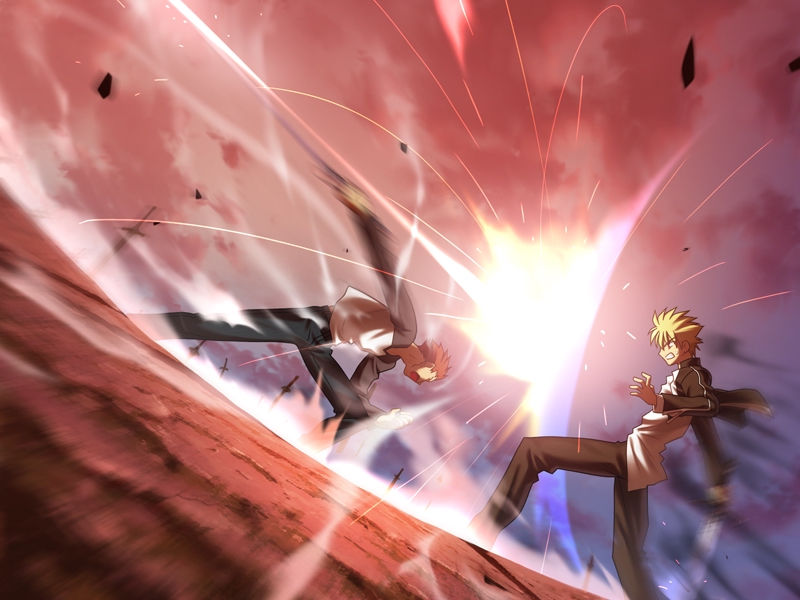
Example of a Computer-Generated Graphic depicting a battle in Fate/Stay Night.
While “Fate/Stay Night” was meant to be a standalone project, its immense popularity spawned a large number of follow-up works, including sequels and prequels. One of those such works is “Fate/Hollow Ataraxia,” which is a visual novel sequel of “Fate/Stay Night.” Ataraxia’s continuation of the story of Stay Night proved to be difficult due to the divergence of the routes and the varying results in each of the timelines. However, the story for the visual novel focuses on what appears to be the protagonist from Stay Night, and the story ‘encompasses the endings of all of the routes, while not being any of them.’ However, as there is an end to the story in the visual novel and following events; hence, it was stated that the novel continued out of the ending of a certain rate of Stay Night, but also stated that readers should not think too much about it. Being a visual novel with a similar format as the first novel, the presentation and experience of the player remained about the same in this sequel. Around that time, Stay Night was also adapted into a graphic novel (manga), and an animated television series (anime). These two adaptations, while having the liberty of being in a different format, suffered from the adaptation into a format restrained by time, and thus covered a slightly altered version of the story, with an amalgamation of events from all three routes, but ending with a single route. However, soon after, a prequel novel series, “Fate/Zero” was released, and was also later adapted into an anime.
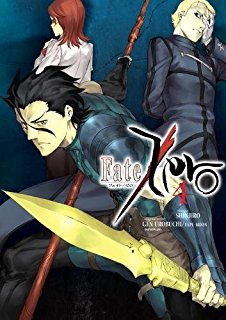
Cover of a novel in the Fate/Zero series.
“Fate/Zero” explored the many events that occurred ten years before the events of Stay Night, events which would eventually shape the circumstances surrounding Stay Night. Being written in a more expository format that detailed the previous Holy Grail war instead of focusing on a single character’s development, Zero followed a chronological set of events, swapping back and forth between different factions while establishing backstories for various characters. This was later easily adapted into an animated series, with the perspectives and orders of events already being set in paper, and being provided with an ample timeframe of episodes so that the plot could be properly told without being rushed. However, while Zero was adapted very well, a movie for the second route, “Fate/Stay Night: Unlimited Blade Works” was released, and as constrained by the movie format, was 105 minutes long, not ample enough to exposit the full contents of the route.
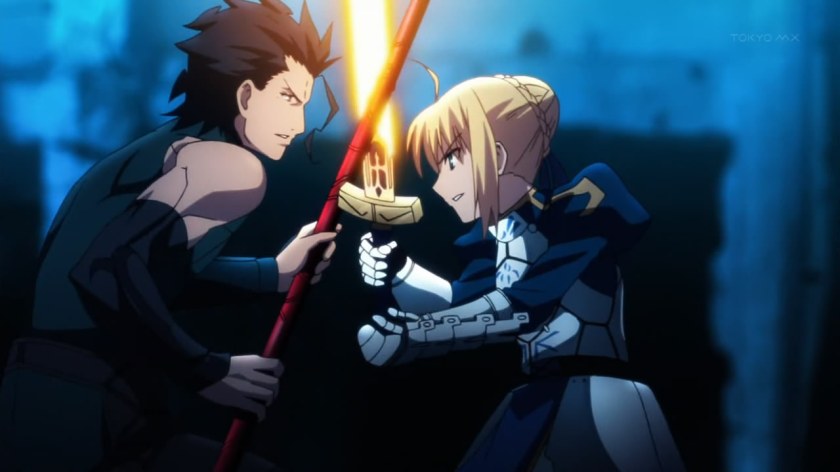
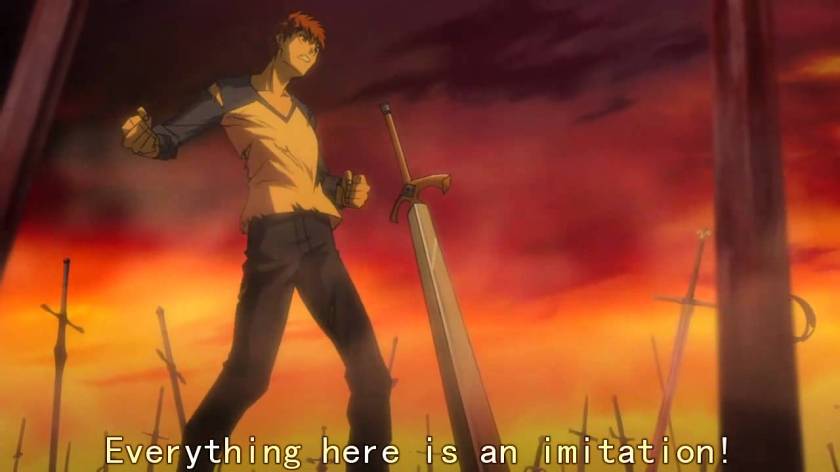
Comparison of Fate/Zero anime (above) and the Unlimited Blade Works movie (below).
Due to this, ‘Unlimited Blade Works’ was re-adapted into a longer animated television series, much as Zero was. Given this ample timeframe, the route was adapted in a slower-paced way that allowed for proper exposition and depiction of the protagonist, crucial to its themes as a Bildungsroman. With proper character development and depiction of the struggles the protagonist faces, as well as with flashier battle sequences than the visual novel could hope to provide, the anime series was a fantastic adaptation of the source material that allowed one to enjoy the work regardless of experience with the series, but was altogether more enjoyable if one were familiar with the series, as with any other series continuity. A few years later, in 2017, a movie release of the first part of the third route, ‘Heaven’s Feel’ followed. Regarding the time constraints of the movie format, this route was split into a trilogy of movies. With this format, the movie sought to split the movie into three major parts of the character’s realizations to segue into another. Additionally, time is saved by the omission of heavy explanations of every detail, with certain parts that are expected to be known in the beginning are shown as a shot-by-shot exposition. The producers behind the movie stated that the wanted to have multiple levels of immersion with the movie: the movie would still be enjoyable if you were not familiar with the series, but the more depth and knowledge one had of the franchise would serve to increase the enjoyment of the movie, scene by scene, and detail by detail. By drawing on the rich history of source material, the allowances today’s technology makes, and expanding the time, it was possible to go from a movie that was commercial bust to one that was very lucrative and popular.
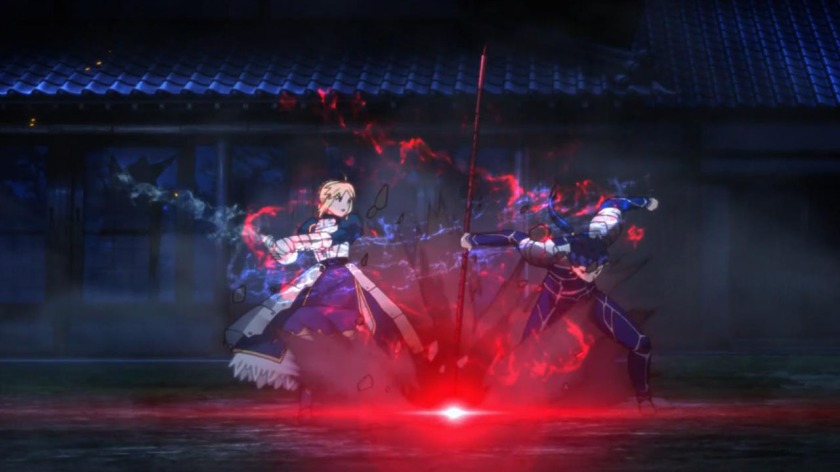

Unlimited Blade Works anime (top) and Heaven’s Feel movie (bottom).
Now, the biggest part of the franchise is one of the more recent releases in the franchise, the mobile game “Fate/Grand Order,” which was launched in 2015. Currently available in seven global markets, including Japan, China, the United States, and Korea, the game is responsible for repeatedly single-handedly bringing Sony Music’s profits record highs. Being free-to-play, but offering a higher chance at premium content by purchasing in-game currency with microtransactions, Grand Order is the top-grossing app on multiple app stores across platforms around the world. The game features a mixture of features: one can collect different ‘Servants’ from different times and places, including characters such as Arjuna from the Mahabharata and Thomas Edison from America, features stories with these ‘Servants’ in a visual novel format, with scrolling text, character sprites, music, and choices to be made, and also a ‘game’ portion where the player can use the servants they have collected to battle epic enemies and obtain materials required for progression through the game. By mixing content and features of different kinds of media, the Fate franchise has proved to be successful, making a lot money and capturing the hearts of many fans. This kind of innovation continues to this day, with an animated series, a Virtual Reality demo, and an Arcade game released related to the series, with more content to come. By expanding the horizons with different media with differing approaches depending on the medium, authors can use different techniques to delivery various types of stories to better effect.

Screenshot of Grand Order

Revenue Ranking of Grand Order

Nice post! I like this case study of a franchise that has maintained its relevancy throughout the ages by adapting to evolving technology and media.
Woah… even as someone already somewhat familiar with the whole franchise, I am impressed by the depth of information you’ve covered. Reading your post was really interesting, and it made me think about a few things regarding the visual novel genre in general and the Fate series in particular. I think that, as a form of media combined from the features of other media, (the text from the good ol’ novel, pictures and sound from movies, interactive decision-making aspects video games) the visual novel is like a perfect jack of all trades. It could make excellent use of all these advantages of each medium – relieving the player/reader of being constrained to a single medium for an extended period of time and keeping things fresh by constantly exposing them to alternate media. It could cater for all tastes and is an unique storytelling experience.
Also, do you think that remediating the Fate franchise actually makes the quality fall off? I mean, Fate Grand Order is definitely a success, but as you said, the orignal Fate Stay Night released before Unlimited Blade Works was a failure, and according to what I’ve heard, newer works like Fate Apocrypha have not quite been satisfactory for fans of the series. (Let’s not mention Fate kaleid and its particularly curious change of direction) It seems that remediation does pose a considerable risk to the faithfulness of the original work and the enjoyment of its followers.
At first, when I was reading your blog post, I only expected the franchise to go through the stages of visual novel, manga, and anime, but I was pleasantly surprised to read that it was a large success as a mobile game as well. However, I am now wondering how much a mobile game with user-guided combat and other features can stick to the original visual novel’s style/ideas. I feel as if the content would have had to evolve a lot throughout this period of time; it would be an interesting question to pursue and find out how much the feel of the “Fate” franchise has changed from visual novel to mobile game.